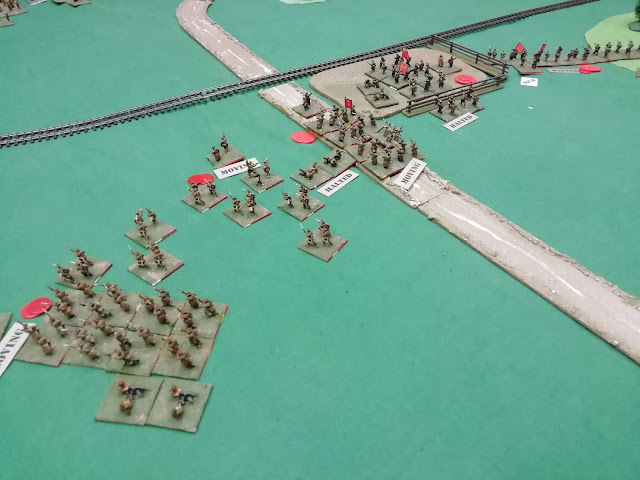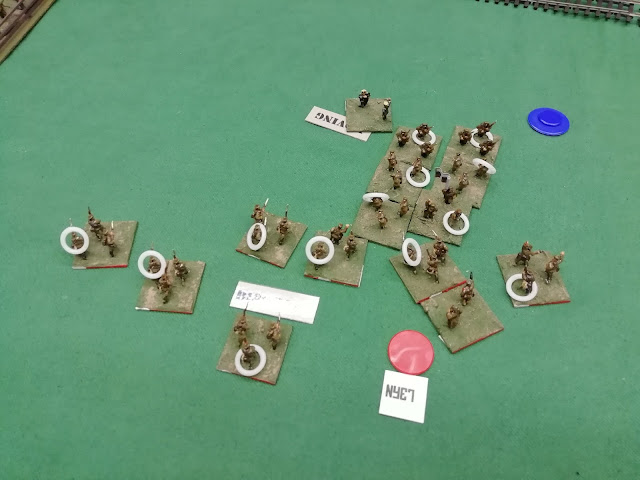After the RCW shenanigans with Neil Thomas' OHW a couple of weeks back, I revisited the period with "For Whom the Dice Rolls" having produced some period tweaks. The more I thought about it the more some of the mechanisms - such as the card activation system - would work really well for some of the things I want to simulate in the period. There are some ideas in my existing RCW sets that could easily be grafted on. Why not give it a go?
As this was a proof of concept game, nothing too fancy. 8 units a side. The Whites have 4 battalions of good quality infantry, a couple of units of Cossacks, and a further couple of Regular cavalry. These are variously supported by MG companies and Tchanka MG carts, which are not integral to the parent units. The Reds got two regiments of three battalions of infantry, plus two units from the Konarmy (that's Red Army Cavalry to the uninitiated) again supported by MGs, Tchankas etc.
Overall the Whites were better quality, with more MG support all round. I thought this would be balanced by the Reds having more small arms firepower.
For this game there's a new infantry formation ("Mass" or "Attack Column") and also a new cavalry formation too ("Line").
The Reds, consisting of Ian in the centre, Will on the right and Phil on the left with the cavalry, won the initiative, and set off for the enemy and to occupy as much terrain as possible. Will's foot was slightly flaky quality (NB the pictures aren't the normal quality. I was using my phone as I forgot my SLR, then it really, really, started to rain so I decided not to go back into the house to get it.)
Richard took the White cavalry, and immediately advanced aggressively towards Will. Jon had the White infantry in the centre.
Richard also moved up his other regular cavalry in march column. He thought this was the cavalry equivalent of "Mass". It isn't. It caused embarrassment later on.
Ian's Regular Red Army infantry join the general advance.
Will occupies the station (alas the building had to go to fit the little chaps in). Ian's left hand battalion is heading for the farm - "stanitsa" - to secure that flank.
End of the first turn, and with the White cavalry monopolising their activation cards, Jon's infantry hasn't moved much.
Here's a close up of the Konarmy moving up on the Red left. Phil has a cavalry unit in line, lurking at the edge of the wood. Very Dr Zhivago.
Here's Richard's cavalry on the White left. He's eyeing up Will's infantry. He thinks he can get the drop on them, so to speak.
With a lightening fast sequence of activations Richard pulls up his Tchanka, and machine guns the troops in the wood, before flanking them with his cavalry. This looks very bleak for Will. Only an extreme dice roll outcome can possibly save him.
Richard duly obliges, and Will drives him off, but at some loss. There is much crowing in the Red camp at this victory (plus umpire takes notes about the close combat system and its applicability to cavalry).
Will now deploys into line, to give the White cavalry a farewell volley. It's fairly ineffective.
Undeterred by their colleagues' failure, Richard's other regular cavalry charge Will's line in the open. BTW you can clearly see a "Coercion" marker behind that line of infantry, as they had to be encouraged by the local Cheka earlier in the game to perform their duty for the Revolution.
Having been previously shot up a bit by Richard's Tchankas and so having some damage and also being disordered, Will's unit inflicts little damage on the cavalry with its volley of rifle fire. Ricard's cavalry overwhelm them and they flee (query on cavalry pursuit moves, as this isn't a thing in FWTDR).
The Whites now have to pass the turn over to the Reds, and Phil forms up his closest cavalry unit and sends it to plug the hole.
Luck turns for Richard again. Ordered to charge some skirmishers in the open his Cossacks move once, then refuse. They are coerced once, but when they refuse a second time despite the best efforts of their pistol waving officers they just won't budge.
Sat in the open, the Reds shoot them up a bit.
The White perspective. They hold the wood on their left, and have moved up an infantry battalion to help out the mutinous Cossacks, but otherwise their infantry is fairly inert.
Phil's Tchanka succeeds in shooting up Richard's chaps who broke Will's infantry, and he follows it up with a charge.
Richard obliges with another rotten dice roll, and is driven back to the table edge.
Richard has another go in the wood, and is driven off again.
With the cavalry in disarray, it is time for the White infantry to step up. They two battalions who were in reserve, rush forwards in a cloud of skirmishers.
Spotting that the centre of the Red line was being held by a thin screen of skirmishers who had just disobeyed an order, Jon launched his infantry en-mass at them in a vigorous close assault.
The Reds are thrown back in considerable disarray, and Jon still has activations left to exploit the gap - once the turn reverts to him.
Catching the Cossacks completely by surprise, he charges home, routing them.
Back to the centre, Jon's massed infantry charge into another Red battalion which had mutinied in the previous turn, breaking them (I took them off before the picture).
They then switch their attention back to the first unit they attacked, breaking them, but only after taking some damage.
I had to end the game there, due to time pressure and I wanted to have 30 minutes for a wash up session. The players were mostly supportive, although one preferred the previous OHW version, as it was much easier to understand. I can't argue with that. OHW is certainly much simpler.
The consensus was that the system help up pretty well, and gave a good RCW flavour (Jon's report on the game is here). We had sweeping cavalry charges, manic bayonet assaults, and recalcitrant troops on both sides. I took a page of notes away to work on, which go with the need to add armoured cars and trains in due course. This game also didn't have any artillery in it either, which may disturb the dynamic without some surgery.
I need to go back to my books, and refresh my memory on what I want to see in an RCW game. I've looked back at my previous rule sets to deduce what story they are trying to tell. The effect of artillery seems to be less, I think, and armour has a significant morale effect too.
My other concern is whether this is a standalone rule book or a supplement. My first thought was "supplement", (hence the current title "It Rolls for Ivan") but I'm not sure on the RCW/SCW crossover in the wargaming community, and if I put in all the background like in the SCW book, it might be an equivalent sort of size anyway. Which is to say I don't think I'll be able to get it down to the size of "Indian Mutine-era" and sell it for £5. One for me to ponder.





























That's a great game for a first outing. As you say, trying to fit in artillery, tanks, armoured cars and armoured trains might change things quite a bit. I always find trying to fit a 'classic' cavalry engagement into 'modern' warfare quite a hard thing to achieve.
ReplyDeleteMy initial thoughts were for a supplement, but the above might mean a stand alone book is more appropriate?
Getting the game balance right between all those elements is going to be a challenge. The activation system will probably let cavalry charges happen if you time everything right. Armoured cars are the big challenge. Armoured trains are really mobile artillery at a tactical level, and you shouldn't be detraining infantry straight on to a battlefield. Looking at what might need to go in the book orbats etc), cutting out the duplicated rules might only save 6-12 pages any way in a 90 page book. That'll hardly save 50p in production costs.
DeleteAwesome game, Graham !!! I liked it very much! Chanka, I suppose it's Tachanka?
ReplyDeleteThanks for the endoresment. That's important coming from you. When I first started playing RCW there was a Ukrainian porn star who called herself "Tachanka", so I settled on spelling it "Tchanka" to save embarrassment on the home PC when googling for information.
DeleteThanks for hosting the game. I always enjoy seeing your close-up photos after having spent the session peering at the table from afar. This game was more satisfying to me than the OHW contest. The Whites would have benefitted from winning an initiative turn and getting a few more cards in play.
ReplyDeleteYou're welcome. I really enjoyed the game. I thought it had a lot of flavour. These pictures aren't the best as I wasn't using my SLR. You certainly suffered from a lack of initiative. Knowing you, however, for game number two you'll be much more clued up on how you want to play the game.
DeleteOne question for you on hand management and card play for multi-player games in this series. We have played it both where the commander draws all cards and allocates activations to each subordinate and where each player draws a subset of the total card allocation and plays from his hand. Which method do you prefer?
DeleteFor Game #2, I may be more clued-up on how to play the game but I have resigned myself to never expecting to out-roll Phil (and plan accordingly).
Hand management in remote games with multiplayers is an issue. For me as umpire it helps having one player with all the cards, calling the high level shots. However, with multiple brigades/regiments in IRFI AND the potential that you can move on any suit I'm wondering about all players having their own cards, and drawing their own hand. The downside with that is it becomes harder to string together a series of actions.
DeleteI'm sure the initiative worm will turn.